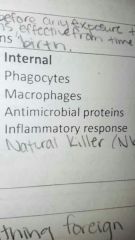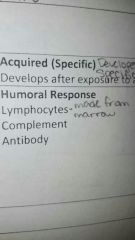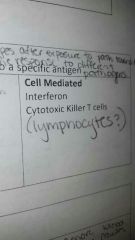![]()
![]()
![]()
Use LEFT and RIGHT arrow keys to navigate between flashcards;
Use UP and DOWN arrow keys to flip the card;
H to show hint;
A reads text to speech;
62 Cards in this Set
- Front
- Back
|
3 domains of life |
Bacteria Archea Eukarya |
|
|
Microbes-can't see they are so small |
Decompose Needed for life Take up space so bad things don't take hold Produce more than 1/2 earth's atmosphere Exist all over |
|
|
Nitrogen is fixed into a useable state by |
Bacteria and archea |
|
|
Fungus |
Decomposer that breaks down outside and absorbs nutrients |
|
|
Non living non cellular parasite |
Viruses |
|
|
HIV |
Human immunodeficiency virus causes aids, runs on lysogenic cycle Envades t cells and mutates easily |
|
|
All viruses have |
Genetic material or a protein coat (capsid) |
|
|
Archea |
Single celled prokaryotes that reproduce by binary fission |
|
|
3 classes of extremophiles |
Thermophiles-hot environments Halophiles- salty environments Anerobes-live without o2 |
|
|
Single celled eukaryotes, microscopic and like our cells, live in most environments, 100,000 species , first to sexual lyrics reproduce |
Protists |
|
|
Plant lje protosts |
Algae |
|
|
Colonial multicellularity |
Individual cells form stable groups and specialize in functions |
|
|
Phytoplankton |
Microscopic algae that do photosynthesis and are temp. Sensitive |
|
|
Heterotrophic protists (amoeba) |
Eat organic matter |
|
|
Heterotrophic organism's that consume organic material and decompose to externally digest their food |
Fungus |
|
|
Hyphae |
Webs of tubes that grow towards food sources and make branches called mycelium |
|
|
Fungus reproduce by |
Spores |
|
|
Lichens |
Algae and fungus in a symbiotic relationship |
|
|
Multicellular, fixed in 1 spot, carry out photosynthesis, have a cell wall and chloroplast |
Plants |
|
|
4 categories of plants |
Bryophytes Seedless vascular Gymnosperms Angiosperms |
|
|
Bryophytes |
Live near h2o so sperm can swim to eggs, lack vascular system ex. Moss and liverworts |
|
|
Seedless vascular plants |
Have vascular system, no seeds and need h2o to reproduce ex. Ferns and club moss |
|
|
Gymnosperms |
Produce male and female cones that induce plant embryo, food supply, and protective casing. Spread by wind once germinated Ex. Spruce trees |
|
|
Angiosperms |
Flooring plants that produce seeds encased in fruit. Includes most trees besides conifers and pollen is transfered by organismd |
|
|
Gravitropism |
Plants can sense where they are with respect to the earth and light and will grow accordingly |
|
|
Phototropism |
Plants will bend towards source of light |
|
|
Thigmotropism |
Plant grows in response to touch, and can climb upwards like ivy, to gain access to light |
|
|
Photo perodism |
Plants can respond to changes in darkness relative to light |
|
|
Long night plants |
Flower with increasing in darkness |
|
|
Short night plants |
Flower with decrease in darkness |
|
|
Recognize antigens, make antibodies, give rise to plasma cells and memory b cells |
B cells |
|
|
T cells |
Attack infected cells |
|
|
Helper t cells make |
B cells and memory t cells |
|
|
Killer t cells |
Cytotoxic t cells that give rise to active Killer t cells that kill infected cells |
|
|
Producing cells that destroy the body's own cells when they are infected, mostly using t cells |
Cell mediated immunity |
|
|
T cells and b cells are found in |
The lymphatic system |
|
|
Mistakes in the immune system result in |
Autoimmune disorders, when immune system attacks itself |
|
|
Immune system overreaction resulting in histamine being released |
Allergy |
|
|
Inate or non specific |
Present before exposure to pathogens, effective from time of birth |
|
|
Inate external examples |

|
|
|
Inate internal exampled |

|
|
|
Acquired or specific |
Developed after exposure to pathogens and specifically reacts to different pathogens |
|
|
Humoral response examples |

|
|
|
Cell mediated examples |

|
|
|
Antigen |
Anything foreign |
|
|
Inflammation (nonspecific) |
Histamine and other chem released from injured cells causing more blood to be released to harmed regions |
|
|
Antimicrobial proteins |
Personal lysol |
|
|
Phagocytes (nonspecific) |
Types of white blood cells that ingest invading organism's and initiates inflammatory response |
|
|
Macrophages (nonspecific) |
Type of phagocytes that migrate thru body and found in lymphatic system |
|
|
Complement (nonspecific) |
System made of 30 proteins that lyces infected cells and caused inflammation |
|
|
Innate defenses against viruses that helps activate macrophages and will interfere with virus infection so immune system has a chance to activate |
Interferons |
|
|
Causes inflammation and swells blood vessels |
Histamine |
|
|
Apoptosis |
Cell death |
|
|
Natural killers |
Look for cancer cells and attacks infected cells causing apoptosis |
|
|
Recognise antigens and antibody binding sites tagging them for destruction |
Lymphocytes |
|
|
Found in blood and bind whole antigens |
B lymphocytes |
|
|
Found in blood and bind pieces of antigens to make polypeptide chains |
T lymphocytes |
|
|
MHC |
Haworth histo compatibility, complex t cells bound to normal cell surface proteins called MHC proteins. Then sends killers |
|
|
Epitopes |
Antigen binding site used by viruses to infect out cells |
|
|
Bone marrow |
Where immune cells are madr |
|
|
Acquired immunity step1 |
3-5 days specific immunity kicks into make memory t cells or b antibodies |
|
|
Acquired immunity step 2 |
Memory cells already attaching antigens, don't get sick even thought you are exposed |

